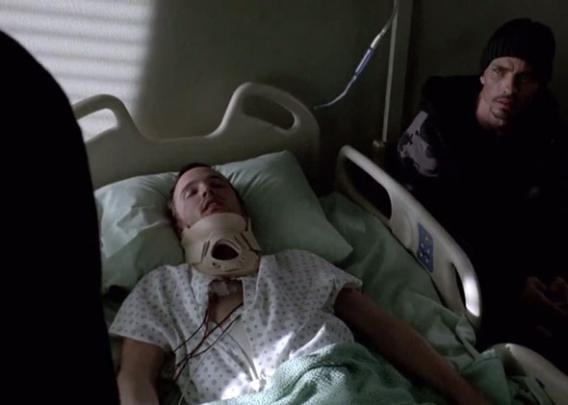Breaking Bad is about a lot of things—the contextualization of evil, the blind bond of family, the consequences of lifelong repression—and of course, the macro and micro-economics of the methamphetamine industry. But wrapped within all of this is a medical drama unlike any other, possibly the best medical drama on TV, ever.
Not that current medical dramas offer any meaningful competition. Personal disclaimer: As a physician, I can’t stand watching medical dramas. They are inaccurate, over the top, and give a very poor representation of the environments we work in, the nature of the work, and the people involved. But my wife sees enough, leaving me to explain that not every shower taken in the hospital involves collateral canoodling à la Grey’s Anatomy or that it’s impossible for me to simultaneously do both surgery and cardiac catheterization and run all my own lab tests à la House. Even when there are interesting subplots, deeper themes, or stellar performances, the lack of overall believability makes it hard for me to become engrossed or to separate the medical setting from the drama.
While most medical shows—much like the health system at large—focus on acute presentations, hospitalizations, and procedures, Breaking Bad follows its patients far beyond the walls of the hospital. When Hank, the DEA agent brother-in-law of the show’s meth-cooking protagonist, Walter White, is shot by the cartel, he is immediately rushed to a hospital where he gets the usual TV doctoring: wailing sirens, complex jargon, rickety stretchers and tense surgeons. But while most shows would either move on to the next thrilling emergency or end with the patient disappearing into the credits, Breaking Bad did neither. After initially being scared witless by the thought of being discharged, Hank spent almost an entire season in bed, obsessing over minerals and pornography. He became depressed, despondent, and angry. He vacillated between motivation and apathy. In short, he didn’t stop being sick as soon as the bullets were pulled out of his chest or when he was discharged from the hospital. If anything, that’s when his journey started. While most shows focus on the heroics of EMTs, surgeons, and doctors, Breaking Bad shows that the heroism of patients and their caregivers goes on long after they have moved on from an acute care facility. And importantly, Hank walks with a limp to this day, dispelling the notion of magical cures.
Another telling scene that somehow escapes the attention of most medical shows is the look on the faces of Skyler and Marie, Walt’s and Hank’s respective wives, when they receive their spouses’ medical bills. Not only do the bills make no sense to them, the doctors appear as bamboozled and helpless as the patients. In fact, a popular Internet meme suggests that Breaking Bad would not have been possible in a system which provides universal free health care, such as Canada’s, because Walt would never have been desperate to collect the money for his treatment.
Cancer, in Breaking Bad as in modern life, is a metaphor as well as a disease. Breaking Bad is one of the best televised depictions of cancer the metaphor (the cancer of evil, drugs, betrayal, and greed) and easily the best depiction of cancer the disease. When Walt gets diagnosed with Stage IIIA lung cancer in the first episode of the show, he is given two years to live. The depersonalization that he experiences is what most patients feel after receiving an initial diagnosis of cancer. But the lack of an outward reaction may well mask volcanic turbulence inside. A cancer diagnosis doubles a patient’s risk of suicide; among all cancers, that risk is highest in patients with lung cancer. Furthermore, even among patients with lung cancer, an even higher risk of suicide is present in older white patients. The question really is: If Walt had received aggressive social support early on, would it have helped him cope better with his diagnosis and averted his foray into the “empire business”?
For large swathes of time Walt’s cancer remains quiescent, but it is always simmering under the surface. You can see its effect on Walt if you look closely enough at his eyes, wavering as they narrow into a sharp squint behind his 1980s-style eyeglasses. The vast majority of his treatment is as an outpatient, reflecting how oncology treatment has evolved. But even as Walt’s cancer remains in remission, it never really leaves him. At no point does Walt stop waiting, waiting for the cancer to return.
Breaking Bad did have one notable flub. When Hank’s shooter is admitted in the hospital, the rest of the DEA seems to have open access to his room. In reality though, patients suspected of crimes have very limited access to visitors, and their privacy is protected, at times even more vigorously than other patients’ because of ongoing investigations and media interest. Having recent firsthand experience of what it feels like to work in a hospital housing a high profile terrorism suspect, that one scene stood out as odd and improbable.
Breaking Bad shows that cancer affects the mind, even when it isn’t metastasizing to the brain. It isn’t inconceivable to think of Walt’s alter ego—Heisenberg—as the cancer that afflicts his mind the moment he learns of the malignancy in his lungs. There is something to be said about how realistic Hank’s physicians are about what his prognosis is and what his treatment can achieve. Such honest and accurate prognostication, in my view, really helps patients have reasonable expectations about their disease. Importantly, it sets patients up to live their lives to the fullest and frees them from the trappings of irrational optimism. While this new-found freedom sets Walter on an ascendant journey towards meth immortality, most patients I guess find less destructive outlets for whatever they may have repressed. In Walter White though, Vince Gilligan, the creator of Breaking Bad, has produced the most plausible character study of the ravages of cancer, embedded in a show every physician should watch.
